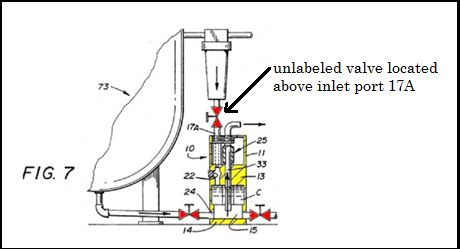This case provides an example of how a patent applicant can get positive results at the U.S. Court of Appeals for the Federal Circuit (Federal Circuit) after unsuccessful prosecution at the United States Patent and Trademarks Office (USPTO) and the Patent Trial and Appeal Board (PTAB).
The applicant in this case filed U.S. patent application No. 12/906,222 (the 222 application), which is directed to a valve assembly for draining contaminants, condensation, and other fluids that adversely affect the efficiency and function of a pressurized system.
For example, claim 1 of the application recites:
a drain valve comprising:
a. a valve body, wherein said valve body defines an inlet seat and a first outlet seat downstream of said inlet seat;
b. a first member, wherein said first member has a first position in sealing engagement with said first outlet seat and a second position separated from said first outlet seat;
c. a second member, wherein said second member has a first location in sealing engagement with said inlet seat; and
d. a sensor downstream of said inlet seat, wherein said sensor generates a signal reflective of a pressure downstream of said inlet seat.
During prosecution at the USPTO, the Examiner cited the following prior art references against the 222 application: U.S. patent No. 5,531,241 (Rasmussen) and U.S. patent No. 3,262,464 (Frantz). Specifically, the Examiner found that Rasmussen anticipated claims 1–3, 5–8, and 15–20 under 35 U.S.C. § 102(b), Frantz anticipated claims 1, 2, 9, 10, 14–18, 20 and 21 under § 102(b), and the two references collectively render all claims obvious under § 103.
Subsequently, the PTAB affirmed the Examiner's rejections. The applicant appealed the PTAB's decision to the Federal Circuit.
The Federal Circuit reversed the PTAB's anticipation determinations, vacated its obviousness determinations, and remanded the case for further proceedings.
Specifically, the Federal Circuit reversed the PTAB's anticipation determination with respect to Rasmussen as to claims 1-3 and 5-8. At issue was claim 1's recitation of an "inlet seat" that is defined by a "valve body." The Examiner found that Rasmussen inherently discloses such an inlet seat within an unlabeled valve depicted in Rasmussen's Figure 7 above inlet port 17A. The PTAB found that Rasmussen's unlabeled valve is "connected to, and therefore allows or prevents flow into, inlet port 17A," and that the seat of the unlabeled valve would therefore "be an internal part of and contained within the outer casing of drain valve 10."
Figure 7 of Rasmussen is shown below with annotations.

The Federal Circuit disagreed with the PTAB. The Federal Circuit found that the unlabeled valve (shown in red above inlet port 17A) resides above the housing 11 that contains the other valve components (shown in yellow). The Court found that the unlabeled valve and the inlet seat therein is not "an internal part" of and "contained within" the outer casing of the drain valve. The Court concluded that Figure 7 clearly shows that the valve is external to and outside Rasmussen's casing.
Further, the Federal Circuit reversed the PTAB's anticipation determination based on Frantz as to claims 1–2 and 21. The PTAB had affirmed the examiner's determination that Frantz anticipates the claims, agreeing with the examiner that Frantz's piston stem 14 and piston head 18 collectively constitute the claimed "sensor" because they sense pressure insofar as they move in response to the pressure applied thereto. The PTAB concluded that Frantz's piston stem and head generate a "signal" in the form of a mechanical force determined by the pressure in the valve chambers.
However, the Federal Circuit found that the PTAB's construction of the term "signal" was unreasonably broad and inconsistent with the description of the application. The Federal Circuit noted that the PTAB construed the term "signal" as encompassing "an act, event, or the like that causes or incites some action," which would encompass virtually any mechanical component within the valve drain that moves in response to the flow of fluid through the drain.
In the same way, the Federal Circuit noted that the description of the 222 application explains that the sensor "may transmit the signal to an indicator, such as a pressure gauge or alarm system, to provide a visual or audible indication of the operability of the drain valve," and that a controller can "compare the signal to a predetermined limit and generate a control signal based on this comparison." The Federal Circuit found that it is clear from this description that the signal must at least be capable of being compared to a "predetermined limit." Hence, the Court concluded that, under any reasonable construction of "signal," Frantz's piston stem and head combination cannot fairly be characterized as a sensor that generates a signal that is reflective of a pressure downstream of the inlet seat, as claimed in claim 1. In the same way, the Federal Circuit found that the movement of Frantz's piston cannot be compared to a predetermined limit, as described in the 222 application; thus, Frantz does not disclose a sensor that generates a "signal".
Finally, the Federal Circuit found that the PTAB's obviousness determinations involve insufficiently or inappropriately explained factual findings, vacated the PTAB's obviousness rejections with respect to claims 1–3, 5–8, and 21, and remanded for further factual findings and explanations. An official version of the decision is available on the website of the U.S. Court of Appeals for the Federal Circuit.
A patent applicant can choose to challenge an examiner's adverse decision by initiating an appeal with the PTAB. Further, if unsuccessful at the PTAB, the applicant can always try her chances at the Federal Circuit by appealing the PTAB decision.
The content of this article is intended to provide a general guide to the subject matter. Specialist advice should be sought about your specific circumstances.
